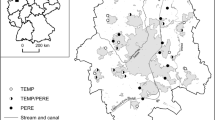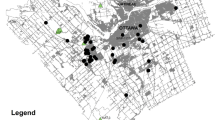Abstract
Adult odonate biodiversity was investigated to understand their relationship with pond management practices and environmental conditions in a rapidly urbanized landscape. Twenty-four farm ponds in Taoyuan City were selected and classified into five pond groups based on pond management practices. In total, 21 species, 17 genera, and 6 families of odonates were recorded for a total of 5701 individuals between June 2014 and July 2015. The abundance of Odonata was unrelated to pond size or distance to the nearest pond; however, odonate species richness was negatively and significantly correlated with pond size. Pond management practices considerably affected pond aquatic macrophytes and dike construction materials. Ecology park ponds under intense human management and undisturbed ponds without any human management had higher species richness than did the ponds in the other three fish farming groups. Species richness was highest in small and human-modified ponds. By contrast, species richness was lowest in two fish farming pond groups. These results suggest that pond management practices can increase or reduce odonate species richness depending on the alteration of pond microhabitat features. Our observations suggest that the enhanced habitat quality of small ponds provides an opportunity to protect freshwater biodiversity for local governmental civil servants in urbanized landscapes.





Similar content being viewed by others
References
Angélibert S, Rosset V, Indermuehle N, Oertli B (2010) The pond biodiversity index ―“IBEM”: a new tool for the rapid assessment of biodiversity in ponds from Switzerland. Part 1. Index development. Limnetica 1(29):93–104
Biggs J, Williams P, Whitfield M, Nicolet P, Weatherby A (2005) 15 years of pond assessment in Britain: results and lessons learned from the work of pond conservation. Aquat Conserv 15:693–714
Blicharska M, Andersson J, Bergsten J, Bjelke U, Hilding-Rydevik T, Johansson F (2016) Effects of management, function and vegetation on the biodiversity in urban ponds. Urban For Urban Gree 20:103–112
Brand AB, Snodgrass JW (2010) Value of artificial habitats for amphibian reproduction in altered landscapes. Conserv Biol 24:295–301
Carchini G, Della Bella V, Solimini AG, Bazzanti M (2007) Relationships between the presence of odonate species and environmental characteristics in lowland ponds of Central Italy. Ann Limnol-Int J Lim 43:81–87
Céréghino R, Oertli B, Bazzanti M, Coccia C, Compin A, Biggs J, Bressi N, Grillas P, Hull A, Kalettka T, Scher O (2012) Biological traits of European pond macroinvertebrates. Hydrobiologia 689:51–61
Céréghino R, Boix D, Cauchie HM, Martens K, Oertli B (2014) The ecological role of ponds in a changing world. Hydrobiologia 723(1):1–6
Collen R, Whitton F, Dyer EE, Baillie JE, Cumberlidge N, Darwall WR, Pollock C, Richman NI, Soulsby AM, Böhm M (2014) Global patterns of freshwater species diversity, threat and endemism. Glob Ecol Biogeogr 23:40–51
Corbet PS (1999) Dragonflies: behaviour and ecology of Odonata. Cornell University Press, Ithaca, New York
Davies B, Biggs J, Williams P, Whitfield M, Nicolet P, Sear D, Bray S, Maund S (2008) Comparative biodiversity of aquatic habitats in the European agricultural landscape. Agric Ecosyst Environ 125:1–8
De Marco P, Nogueira DS, Correa CC, Vieira TB, Silva KD, Pinto NS, Bichsel D, Hirota ASV, Vieira RRS, Carneiro FM, de Oliveira AB, Carvalho P, Bastos RP, Ilg C, Oertli B (2014) Patterns in the organization of Cerrado pond biodiversity in Brazilian pasture landscapes. Hydrobiologia 723:87–101
Department of Land Administration, Taoyuan (2016) Land. Taoyuan city government. http://www.tycg.gov.tw/ch/home.jsp?id=59&. Accessed 15 January 2018
Dolný A, Harabiš F, Mižičová H (2014) Home range, movement, and distribution patterns of the threatened dragonfly Sympetrum depressiusculum (Odonata: Libellulidae): a thousand times greater territory to protect? PLoS One 9(7):e100408
Dudgeon D (2010) Prospects for sustaining freshwater biodiversity in the 21st century: linking ecosystem structure and function. Curr Opin Environ Sustain 2(5):422–430
Fang W-T, Chu H-J, Cheng B-Y (2009) Modeling waterbird diversity in irrigation ponds of Taoyuan, Taiwan using an artificial neural network approach. Paddy Water Environ 7(3):209–216
Gledhill DG, James P, Davies DH (2008) Pond density as a determinant of aquatic species richness in an urban landscape. Landsc Ecol 23(10):1219–1230
Goertzen D, Suhling F (2013) Promoting dragonfly diversity in cities: major determinants and implications for urban pond design. J Insect Conserv 17(2):399–409
Hair JF Jr, Hult GTM, Ringle C, Sarstedt M (2016) A primer on partial least squares structural equation modeling (PLS-SEM). Sage, London
Hill MJ, Biggs J, Thornhill I, Briers RA, Gledhill DG, White JC, Wood PJ, Hassall C (2017) Urban ponds as an aquatic biodiversity resource in modified landscapes. Global Change Biol 23(3):986–999
Honkanen M, Sorjanen AM, Mönkkönen M (2011) Deconstructing responses of dragonfly species richness to area, nutrients, water plant diversity and forestry. Oecologia 166(2):457–467
Huang S-L, Lee Y-C, Budd W-W, Yang M-C (2012) Analysis of changes in farm pond network connectivity in the peri-urban landscape of the Taoyuan area, Taiwan. Environ Manag 49(4):915–928
Jeanmougin M, Leprieur F, Loïs G, Clergeau P (2014) Fine-scale urbanization affects Odonata species diversity in ponds of a megacity (Paris, France). Acta Oecologica 59:26–34
Kadoya T, Washitani I (2004) Dragonfly species richness on man-made ponds: effects of pond size and pond age on newly established assemblages. Ecol Res 19(5):461–467
Le Gall M, Fournier M, Chaput-Bardy A, Husté A (2018) Determinant landscape-scale factors on pond odonate assemblages. Freshw Biol 63:306–317
Magurran AE (2004) Measuring biological diversity, second edition. Blackwell, Oxford
Nicolet P, Biggs J, Fox G, Hodson MJ, Reynolds C, Whitfield M, Williams P (2004) The wetland plant and macroinvertebrate assemblages of temporary ponds in England and Wales. Biol Conserv 120:261–278
Oertli B, Joye DA, Castella E, Juge R, Cambin D, Lachav-anne JB (2002) Does size matter? The relationship between pond area and biodiversity. Biol Conserv 104:59–70
R Core Team (2017) R: A language and environment for statistical computing. R Foundation for Statistical Computing, Vienna
Raebel EM, Merckx T, Feber RE, Riordan P, Macdonald DW, Thompson DJ (2012) Identifying high-quality pond habitats for Odonata in lowland England: implications for Agri-environment schemes. Insect Conserv Diver 5(6):422–432
Ruggiero A, Céréghino R, Figuerola J, Marty P, Angélibert S (2008) Farm ponds make a contribution to the biodiversity of aquatic insects in a French agricultural landscape. C R Biol 331(4):298–308
Samways MJ, Steytler NS (1996) Dragonfly (Odonata) distribution patterns in urban and forest landscapes, and recommendations for riparian management. Biol Conserv 78(3):279–288
Sayer C, Andrews K, Shilland E, Edmonds N, Edmonds-Brown R, Patmore I, Emson D, Axmacher J (2012) The role of pond management for biodiversity conservation in an agricultural landscape. Aquat Conserv 22:626–638
Simaika JP, Samways MJ (2011) Comparative assessment of indices of freshwater habitat conditions using different invertebrate taxon sets. Ecol Indic 11:370–378
Šmilauer P, Lepš J (2014) Multivariate analysis of ecological data using CANOCO 5, Second edn. Cambridge University Press, Cambridge
Suski JG, Swan CM, Salice CJ, Wahl CF (2018) Effects of pond management on biodiversity patterns and community structure of zooplankton in urban environments. Sci Total Environ 619:1441–1450
Thomaz SM, Cunha ERD (2010) The role of macrophytes in habitat structuring in aquatic ecosystems: methods of measurement, causes and consequences on animal assemblages' composition and biodiversity. Acta Limnol Bras 22(2):218–236
Thornhill I, Batty L, Hewitt M, Friberg NR, Ledger ME (2017) The application of graph theory and percolation analysis for assessing change in the spatial configuration of pond networks. Urban Ecosyst. https://doi.org/10.1007/s11252-017-0724-8
Tsou MH (2005) Illustration of 120 dragonflies in Taiwan. Wild Bird Society of Taipei
United Nations (2014) World urbanization prospects: the 2014 revision, highlights, United Nations, Department of Economic and Social Affairs. In: Population division (ST/ESA/SER.A/352)
Villalobos-Jimenez G, Dunn A, Hassall C (2016) Dragonflies and damselflies (Odonata) in urban ecosystems: a review. Eur J Entomol 113:217–232
Williams P, Whitfield M, Biggs J, Bray S, Fox G, Nicolet P, Sear D (2004) Comparative biodiversity of rivers, streams, ditches and ponds in an agricultural landscape in southern England. Biol Conserv 115:329–341
Wood PJ, Greenwood MT, Agnew MD (2003) Pond biodiversity and habitat loss in the UK. Area 35 (2):206–216
Yu FC, Chang KT, Liang LS (2013) Multitemporal change analysis of the relationship of water ponds and urban change-Taoyuan, Taiwan. In Geoscience and Remote Sensing Symposium (IGARSS), 2013 IEEE International 2677–2680
Author information
Authors and Affiliations
Corresponding author
Additional information
Publisher’s note
Springer Nature remains neutral with regard to jurisdictional claims in published maps and institutional affiliations.
Electronic Supplementary Material
ESM 1
(DOCX 14.7 kb)
Rights and permissions
About this article
Cite this article
Chien, WC., Li, MH. & Li, HJ. Appropriate management practices help enhance odonate species richness of small ponds in peri-urban landscapes. Urban Ecosyst 22, 757–768 (2019). https://doi.org/10.1007/s11252-019-00859-5
Published:
Issue Date:
DOI: https://doi.org/10.1007/s11252-019-00859-5




